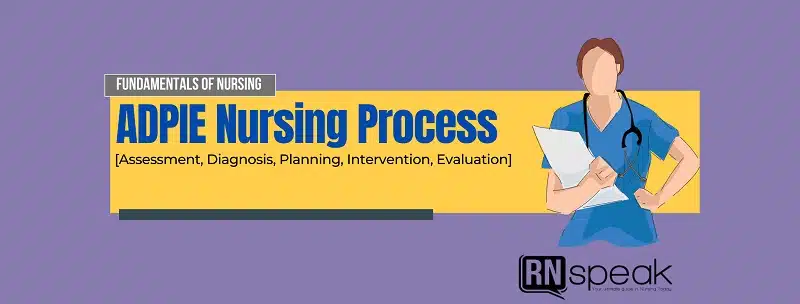As a nurse, you know how important it is to stay organized and focused while providing quality care to your patients. One of the most effective ways to achieve this is by using the ADPIE charting method. In this article, we’ll break down what ADPIE charting is, its benefits, and how you can incorporate it into your daily routine.
Standards of nursing documentation varies from one institution to another. However, regardless of the format, it should meet the standards set. Clear and accurate documentation is essential in determining the quality of nursing care provided. Nurses are LEGALLY accountable to make sure their documentation meets the practice standards. Documentation is a legal requirement, hence, nurses should do it right.
To document a client’s progress, narrative notes, flowsheets, and discharge summaries are used. To communicate client problems clearly, narrative notes often come in special formats depending on the health institution. There are two types of charting in nursing, the first one is narrative charting, and the other one is focus charting. Narrative charting is often taught to student nurses at the beginning then they move on to focus charting. The difference between the two is the amount of data charted. The latter type only includes important events and is supported by other forms of documents like the graphic sheet.
Some of the commonly used formats for charting are SOAP (Subjective, Objective, Assessment, Plan), SOAPIE (Subjective, Objective, Assessment, Plan, Intervention, Evaluation), DAR (Data, Action, Response), ADPIE (Assessment, Diagnosis, Planning, Intervention, Evaluation) and DEAR (Data, Evaluation, Action, and Response). Regardless of the type, these notes are critically important portions of the client’s record.
The acronym system makes it easy to remember the important points to include in the documentation. Although these formats may look different, the logic for writing the progress notes in all of them is similar to that of the nursing process. The client is assessed for data or assessment part, then a diagnosis or conclusion is made and the plan of care follows.
What is ADPIE Charting?
ADPIE is an acronym that stands for Assessment, Diagnosis, Planning, Intervention, and Evaluation. This charting method is designed to help nurses document patient care in a clear and structured manner, ensuring that all necessary information is covered and easily accessible.
Benefits of ADPIE Charting
- Improved Communication
ADPIE charting promotes clear and concise communication among healthcare professionals, ensuring that everyone is on the same page when it comes to patient care.
- Enhanced Patient Care
By following the ADPIE framework, nurses can ensure that all aspects of patient care are thoroughly assessed, planned, and executed, leading to better patient outcomes.
- Streamlined Documentation
ADPIE charting simplifies the documentation process, reducing the risk of errors and making it easier to track patient progress over time.
- Increased Efficiency
By following a structured approach, nurses can save time and energy, allowing them to focus on more critical aspects of patient care and less on writing.
How to Implement ADPIE Charting
To understand how to write progress reports using adpie format lets discuss each component in detail:
A – Assessment
‘A’ stands for Assessment. Included in this area are the subjective and objective data supporting the identified problem. When you say ‘subjective’ assessment it refers to what your client stated. An example of subjective data is the client telling the nurse, ‘My stomach hurts on the lower right side.’ ‘Objective’ data, on the other hand, refers to the cues the nurse observed in the client, including other significant clinical measurements such as vital signs. For example, the nurse observed a facial grimace to the client when he touched the lower right side of his stomach, this ‘objective’ cue can communicate to the nurse that the client is in pain. Another example is blood pressure obtained as 130/90 mm Hg and axillary temperature of 100.4 degrees Fahrenheit.
When assessing the client, the nurse should avoid jumping to conclusions like, ‘I think the client is in pain.’ Recall what the client said or what you observed that supports your identified problem.
D – Diagnosis
‘D’ stands for Diagnosis. After the assessment data are gathered, the nurse analyzes the information and identifies the health problems of the client. Diagnosis provides direction as to what interventions should be used for the client. This part of the charting is usually stated in a three-part format accepted by the North American Nursing Diagnosis Association (NANDA) – the diagnostic statement followed by the statement of the related factor and the defining characteristics or symptoms.
Take note that not all types of nursing diagnoses have a relating factor because the risk nursing diagnosis does not include symptoms since there is just a possibility of an occurrence. The three types of nursing diagnoses are actual, risk, and possible. An example of an actual nursing diagnosis is Ineffective airway clearance (diagnostic statement) r/t bronchial inflammation, edema formation, and increased mucus production (relating factor) as evidenced by dyspnea, increased RR (28 cpm), and nasal flaring (defining characteristics or symptoms). Another example of a nursing diagnosis that is a risk nursing diagnosis is the Risk of Imbalanced Fluid Volume related to increased fluid loss.
P – Planning
‘P’ stands for Planning. Depending on the assessment, a plan of care is developed. Plans may include specific orders designed to manage the problem of the client, and collect additional data about the problem and the goals of care. For example, if the client is in pain, your plan may include: describing nonpharmacological methods to relieve pain and for the client to verbalize pain relief at the end of care.
One of the key components in this phase is creating a goal and outcomes for the patient focusing on the main issue and problem that need to be addressed. These goals should be SMART: Specific, Measurable, Achievable, Relevant, and Time-bound. In the given example of pain management, a goal might be: “After 8 hours of nursing intervention, the client will report a pain level of 4 or less on a scale of 1-10.”
The outcome is a well-documented and easy-to-understand care plan that outlines the goals, interventions, and evaluation criteria. This plan should guide all aspects of the client’s care and ensure continuity between healthcare providers. In addition, the planning phase aims to establish a foundation for achieving positive client outcomes. By having a clear plan, nurses can implement targeted interventions that effectively address the client’s problems and promote their recovery or well-being.
I – Intervention
‘I’ stands for Intervention. These refer to the actions taken by the nurse relevant to the presented problem. For instance, if the client is in pain, the nurse will inform the doctor of the client’s complaint and administer prescribed medications. There are three types of nursing interventions: independent, dependent, and collaborative. Independent nursing interventions pertain to actions a nurse can take without a doctor’s order. They are based on the nurse’s assessment, knowledge, and skills, and focus on promoting health, preventing complications, and maintaining patient comfort. Examples of independent interventions include initiating skin care, frequent change in positions, ambulation, and patient education.
Whereas, dependent interventions refer to interventions that require a specific order from a doctor. The nurse carries out the doctor’s instructions exactly as written. Examples of dependent interventions include administering medications. Collaborative Interventions refer to interventions that involve working with doctors, therapists, and other healthcare professionals to develop and implement a plan of care for the patient. The nurse uses their assessment skills, knowledge, and clinical judgment to collaborate with the team to achieve the best possible outcomes for the patient. Examples of collaborative interventions include arrangements for laboratory and diagnostic work-ups and physical therapy.
E – Evaluation
‘E’ stands for Evaluation. In this area, the nurse evaluates the response of the client to the interventions performed. The primary aim is to determine how well the chosen interventions addressed the client’s problems or needs identified in the “D” (Diagnosis) stage. Did they achieve the desired outcomes set during “P” (Planning)?
Evaluation is an ongoing cycle, not a one-time event. Nurses continuously assess the client’s response throughout the care cycle. This allows for prompt adjustments to the care plan as needed, ensuring the client receives the most effective and personalized interventions for optimal outcomes.
Tips for Successful ADPIE Charting
- Stay Organized
Keep all relevant patient information and documents in one place to ensure easy access and reference.
- Be Thorough
Take the time to thoroughly assess and document each patient’s condition, as this will help ensure accurate and effective care.
- Collaborate
Work closely with other healthcare professionals to ensure that all aspects of patient care are addressed and documented.
- Review and Update
Regularly review and update patient charts to reflect changes in their condition and adjust the plan of care accordingly.
By incorporating ADPIE charting into your daily routine, you can improve patient care, streamline documentation, and increase efficiency. Remember to stay organized, be thorough, collaborate with your team, and regularly review and update patient charts to ensure the best possible outcomes for your patients.






![FDAR Charting for Nurses [5 Tips for Effective FDAR Charting & Common Mistakes to Avoid] Fdar charting](https://rnspeak.com/wp-content/uploads/2023/06/Fdar-charting-238x178.jpg)

